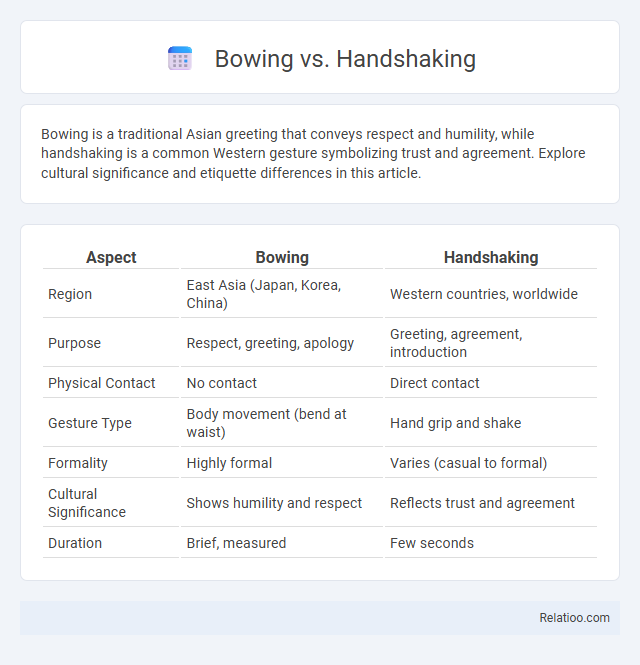Bowing is a traditional Asian greeting that conveys respect and humility, while handshaking is a common Western gesture symbolizing trust and agreement. Explore cultural significance and etiquette differences in this article.
Table of Comparison
| Aspect | Bowing | Handshaking |
|---|---|---|
| Region | East Asia (Japan, Korea, China) | Western countries, worldwide |
| Purpose | Respect, greeting, apology | Greeting, agreement, introduction |
| Physical Contact | No contact | Direct contact |
| Gesture Type | Body movement (bend at waist) | Hand grip and shake |
| Formality | Highly formal | Varies (casual to formal) |
| Cultural Significance | Shows humility and respect | Reflects trust and agreement |
| Duration | Brief, measured | Few seconds |
Introduction to Greeting Etiquette
Greeting etiquette varies widely, with bowing, handshaking, and verbal rituals each reflecting cultural values and social norms. Bowing, common in East Asian countries like Japan and Korea, signifies respect and humility without physical contact. Handshaking is prevalent in Western cultures, symbolizing trust and agreement, while verbal greetings, often accompanied by gestures, are essential for polite social interaction worldwide.
History of Bowing and Handshaking
Bowing originated in ancient Asian cultures as a deep-rooted gesture of respect, humility, and social hierarchy, with evidence dating back to China's Zhou Dynasty and Japan's Heian Period. Handshaking can be traced to ancient Greece around the 5th century BCE, symbolizing peace and the absence of weapons, evolving over time into a universal greeting ritual in Western cultures. Both gestures reflect distinct historical contexts and social customs, with bowing emphasizing deference and handshaking highlighting trust and equality.
Cultural Significance of Bowing
Bowing holds deep cultural significance in many Asian societies, symbolizing respect, humility, and social hierarchy, contrasting with the more egalitarian handshake common in Western cultures. This ritual reflects centuries-old traditions where the depth and duration of a bow communicate different levels of reverence or apology. Understanding the cultural context of bowing can enhance your intercultural communication and show genuine appreciation for the values embedded in these greeting customs.
Symbolism Behind Handshaking
Handshaking symbolizes trust, mutual respect, and equality, serving as a universal gesture to establish agreement or friendship across cultures. Unlike bowing, which often conveys deference or hierarchical recognition, handshaking represents a direct personal connection, signaling openness and willingness to engage. This ritual emphasizes the intention to communicate on equal footing, reinforcing social bonds through physical contact and eye contact.
Bowing vs Handshaking: Key Differences
Bowing and handshaking serve as distinct cultural rituals embodying respect and greeting, with bowing often symbolizing humility and deference in Asian cultures, while handshaking represents equality and agreement in Western societies. The physical gesture of bowing involves a downward tilt of the torso without physical contact, contrasting the firm grasp and shake of hands that convey trust and openness. Understanding these key differences enhances your ability to navigate social interactions across diverse cultural contexts effectively.
Health and Hygiene Considerations
Bowing minimizes physical contact, significantly reducing the transmission of germs and viruses compared to handshaking, which can facilitate the spread of bacteria through direct skin-to-skin interaction. Greeting rituals that avoid touch, such as a nod or a verbal salutation, further enhance hygiene by eliminating contact points altogether. In health-conscious environments, especially during pandemics, non-contact greetings like bowing are recommended for their effectiveness in maintaining personal and public health.
Social Contexts for Bowing and Handshaking
Bowing is deeply embedded in East Asian social contexts, serving as a respectful greeting, a sign of apology, or a way to show gratitude, with variations in depth and duration depending on social hierarchy and occasion. Handshaking dominates Western social interactions, often symbolizing agreement, trust, or the beginning of a formal relationship, with firmness and eye contact reinforcing sincerity. Each greeting ritual reflects cultural values: bowing emphasizes humility and respect, while handshaking highlights equality and openness in social exchanges.
Impact of Globalization on Greeting Norms
Globalization has significantly influenced greeting rituals by blending traditional practices like bowing, handshaking, and local customs into more universally accepted norms across cultures. Your ability to navigate diverse social interactions has expanded as people increasingly adopt hybrid greetings that respect cultural origins while facilitating cross-cultural communication. This shift reflects a growing appreciation for multiculturalism and the practical need for adaptable etiquette in international settings.
Adapting Greetings in a Post-Pandemic World
Adapting greetings in a post-pandemic world requires understanding cultural preferences like bowing, handshaking, and other greeting rituals to prioritize health and social comfort. Bowing remains prevalent in East Asian cultures, minimizing physical contact and reducing viral transmission risks. Handshaking, common in Western societies, has seen a decline due to hygiene concerns, leading to alternative gestures like elbow bumps or verbal acknowledgments becoming more widely accepted.
Choosing the Appropriate Greeting
Choosing the appropriate greeting depends on cultural context and social norms, with bowing being prevalent in East Asian countries such as Japan and Korea to show respect and humility. Handshaking is widely accepted in Western cultures, symbolizing trust and professionalism, especially in business settings. Understanding these distinctions ensures your greeting aligns with cultural expectations, enhancing communication and building rapport.

Infographic: Bowing vs Handshaking
 relatioo.com
relatioo.com